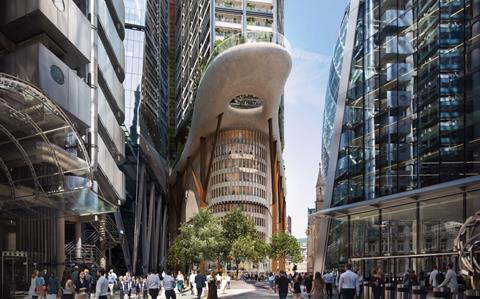Historic England still objecting to City’s planned tallest building despite design amendments submitted last month

Eric Parry’s new vision for the City of London’s tallest building is likely to be approved next week despite a series of scalding objections from heritage groups to the 74-storey tower’s design.
City planning officers have recommended the 1 Undershaft scheme for approval ahead of a planning committee meeting on 2 July with the 309m tall scheme set to become the UK’s joint tallest building with the Shard if it gets the go ahead.
The plans, designed for developer Stanhope, would then be sent to the mayor of London and finally to the secretary of state for final sign off if City councillors vote in favour.
But the planning application is facing strident opposition from statutory consultees Historic England and the Twentieth Century Society despite Eric Parry’s attempts to placate the former with a series of design tweaks submitted last month.
>> See also: Design for Eric Parry’s 1 Undershaft tweaked after Historic England criticism
Historic England’s concerns focus on the impact of the proposals on St Helen’s Square, a public plaza in the middle of the City’s eastern tower cluster which would be largely built over under Stanhope’s plans.
The government heritage advisor has also criticised the design of the tower, which it described as “busy” and a “missed opportunity to achieve an exemplar building at the apex of the cluster”.

Amendments to the scheme outlined in May have toned down the colour palette of the building’s proposed podium levels from a dark terracotta to a lighter brown and softened the shiny covering of a raised terrace level which would be cantilevered 46m above St Helen’s Square.
The crown of the building, which would include two floors as a viewing gallery for the Museum of London, has also been changed from its previous brown colour to a facade of bright red-bordered windows and coloured dichroic glazing.
But Historic England has said the amendments had not been enough for it to withdraw its objection and argued the brighter colours proposed for the tower’s crown had increased the potential heritage harm to the setting of the nearby Tower of London, a world heritage site.
The group said its advice would be included in a report on the state of conservation of the Tower of London which was ordered by Unesco last month and is due to be submitted by the UK government by 1 December.
>> See also: Work on 1 Undershaft helps revenue and profit rebound at architect Eric Parry
Unesco’s request for the State of Conservation report was prompted by concerns about the development of tall buildings in the City’s tower cluster on the 11th century Norman stronghold.
Historic England said in its objection that it is the City’s “duty in the context of this heightened international scrutiny” to take “urgent steps” to minimise harm to the world heritage site by ensuring the 1 Undershaft scheme is as “visually recessive as possible”.

Other objectors include Tower Hamlets council and the GLA itself, both of which have raised concerns around the impact of the scheme on the Tower of London, with the latter also criticising the design of the tower’s crown and its cantilevered terrace.
The plans are also facing criticism from the Twentieth Century Society, another statutory consultee, because of the proposed demolition of the site’s existing 1960s Aviva Tower, which it said should be a non-designated heritage asset.
The objections have been countered in a 503-page report drawn up by planning officers which argues that the scheme’s public benefits outweigh any harm caused to nearby heritage assets.
The benefits are said to include more than 154,000 sq m of office space, nearly 13% of the total needed to meet project employment growth in the Square Mile by 2040, and the community space provided for the Museum of London in the tower’s top two floors.




























1 Readers' comment